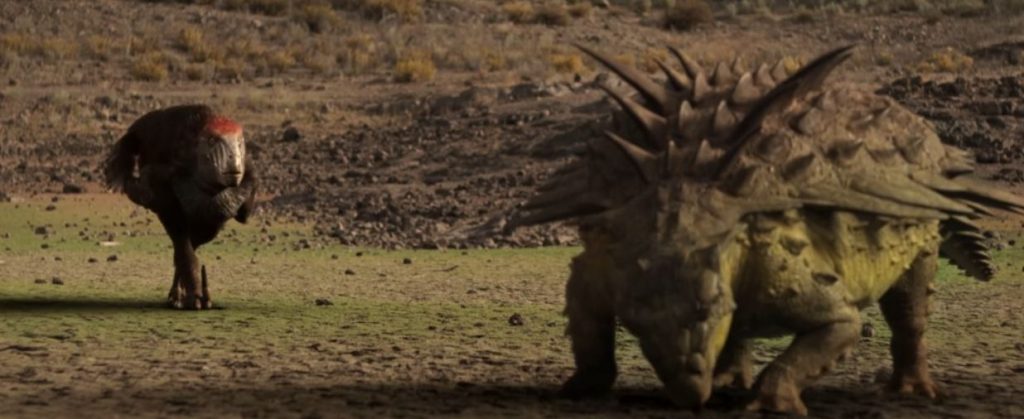Walking With Dinosaurs 2025: Marc’s review

Back in the seemingly long-vanished and quasi-mythical past of…2019, I wrote an article reflecting on the original Walking With Dinosaurs, two decades on from its debut. At the time we were still awaiting an obvious successor; while a number of series had featured computer-generated dinosaurs in the interim, none had matched the grandeur, ambition, confidence, and verve of WWD. Well, we now do have a worthy successor…and it’s Prehistoric Planet. Meanwhile, the WWD name has been attached to various projects, including a stage show (which was by all accounts very impressive), a movie ruined by awful dialogue, and now this. What we have here isn’t a bad series by any means, but attaching the WWD name to it feels unfair, setting sky-high expectations among viewers that simply aren’t going to be met.
All images are copyright the BBC and PBS and that.
Whereas Classic WWD was utterly (and for the time, very bravely and expensively) committed to the conceit of being a nature documentary shot by time travelers, WWD 2025 flits back and forth between the Mesozoic past and the present, with frequent scenes involving groups of scientists digging away at various palaeontological sites – mostly in North America, but also in Morocco and Portugal. Herein lies the main weakness of the show. There’s nothing inherently wrong with showing the modern-day locales where dinosaur fossils are found, nor in showing the hard work behind the scientific discoveries that drive the show. Furthermore, linking the saurian stars of the CG segments directly with specimens dug out of the ground lends them extra believability and another layer of fascination.
The problems with this approach as used in WWD 2025 are twofold. Firstly, cutting in and out of the Mesozoic segments destroys the narrative flow and any sense of immersion we might have felt. I’m sure there’s a desire among the general audience, not just among dinosaur geeks, to become immersed in an unfamiliar world with exotic creatures, something that Classic WWD and Prehistoric Planet can truly offer, but the format here seems almost designed to spoil. Secondly, this wouldn’t have been half as bad if the modern-day segments didn’t consist of scientists having conversations among themselves that are obviously for the benefit of the audience, but without ever acknowledging the cameras or the presence of an audience.
Pachyrhinosaurus returns! No dialogue this time, thankfully.
While I doubt anyone isn’t happy for the scientists to have their time on screen, they aren’t actors, and having them deliver obviously phony conversations that mostly relay only very superficial information feels like a waste. It’s all very well having stunning landscape photography – and there’s plenty of that here – but why aren’t you just letting the scientists explain things to me directly? I know how enthusiastic these people are, I know how much they’re dying to tell us all, and it feels like they’re being held back for the sake of turning this into ‘Walking With Palaeontologists’. Moreover, if you want to show us the scientific process, really show it to us. Don’t show scientists pulling carefully prepped specimens out of a bag and acting like they just found them – show people how it really all works.
These segments feel as if they would have worked much better as bookends, with the scientists free to address the audience directly rather than pretending that they aren’t being filmed. As it is, they serve as a drag on the CG segments, which have a few problems of their own, but also much to commend. The dinosaur designs for this show are absolutely stunning – some of the best ever seen on screen, combining superb attention to anatomical detail with stylistic flourishes that add extra realism, such as nasty facial scarring on predators and individually varying frills on ceratopsians. Massive animals really do look and feel massive, and elephant-sized creatures convey an appropriate level of necessary stiffness, but also power. There are no bouncing, jiggling giant theropods here. In fact, the animation as a whole is also very good – there are moments where things look a little off, but they’re few and far between.
Hello handsomes.
Theropods have lips, maniraptorans have appropriate feathering, there are a lot of closed-mouth and coarse, reptilian vocalisations (especially among the theropods), and everything has a nice, fat, muscular tail (where appropriate). What’s not to like? Well, WWD 2025 does unfortunately indulge in a few dino-docu tropes that Prehistoric Planet avoids. These are, unfortunately, most evident in the first episode, which was the weakest of the lot for me. All of the ‘star’ dinosaurs (Triceratops, Spinosaurus, Gastonia, Albertosaurus, Pachyrhinosaurus and Lusotitan) are based on real individuals dug out of the ground, which is great, and given sometimes cloyingly cutesy names, which is not-so-great. The first episode features Clover the baby Triceratops, a real cutey-pie who constantly makes adorable-worable sounds and befriends an Edmontosaurus baby in the forest, the two nuzzling to confirm their bond. (There’s a lot of nuzzling in this show.) The dinosaurs look great, but it’s all so annoyingly sweet and seemingly trying hard to be kid-friendly. (At least the baby Edmontosaurus is devoured by a T. rex in short order.)
Thankfully, this level of twee doesn’t pervade the other episodes as much. The Spinosaurus episode features some dangerously cute juveniles, but the protagonist is a young adult male trying to raise them. Even if I could hear Dave Hone’s screams over the scenes of it pursuing fish underwater, the animals looked wonderful and the animation was very good throughout. It was perhaps the only episode where the palaeoenvironment felt like a fully realised world; in other episodes, fauna beyond a few key featured species felt lacking. While comparisons with Prehistoric Planet and its brachiosaurid budget feel unfair, Classic WWD also managed this far better (although it, too, had a gigantic budget for the time). I’ve read that this series grew out of a one-off special about Spinosaurus, and can well believe that, as it might be the best episode of the bunch.
Guess who’s back…back again
Elsewhere, the Albertosaurus looked absolutely beautiful, even if some of their behaviours were a bit of a stretch; the idea that their diminished forelimbs were surely used to caress one another felt rather silly, but was actually mooted by the experts themselves. Albertosaurus‘ close relative, Gorgosaurus, also pops up in the Pachyrhinosaurus episode. While I appreciated some of the more realistic depictions of predation, there were also instances when tyrannosaurs slowly walked up to vulnerable baby ceratopsians while snarling and hissing, which reminded me of a heron I saw predating ducklings at a wetland reserve in that the heron did the exact opposite. I can’t help but feel that, in reality, the predators would have struck quickly, snatched the babies, and ran away from the enraged and potentially dangerous parents. Just like that heron (except the heron flew, because it could).
One ought not to be too harsh on this show, as it’s clear that the budget wasn’t Apple-sized and the artists involved really excelled in reconstructing the animals. It mostly suffers from having the WWD name slapped on it. If this was marketed as an original series, or a second series of something like Planet Dinosaur, it simply wouldn’t invite the same unfortunate comparisons with the original or Prehistoric Planet. As it is, it’s still worth a watch, but lower your expectations below WWD levels before starting. There’s much to like, but it equally falls foul of a rather clunky script, is prone to over-sentimentality, and is held back by scenes with palaeontologists that should be a bonus. Overall, I’d give it 3 Hones out of 5. It’s available to watch now on BBC iPlayer in the UK, and I believe it’ll soon be available in the US via PBS.


